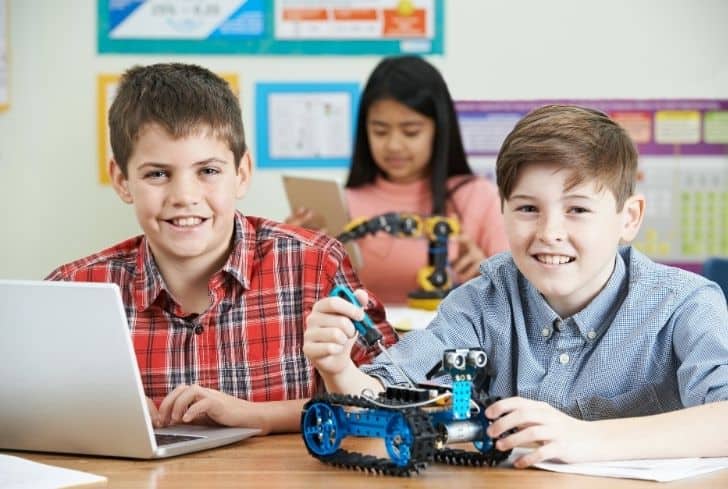New advances in technology continue to push the limits of what we know in healthcare, communication, travel, and education. The application of robotic and simulation technologies have in education has yielded tremendous benefits. They have proven to be excellent educational resources in the learning environment.
Robotics has proven its value in everyday learning and even in the specialized education of students who have disabilities. This field has made a whole lot of areas in education that were thought to be difficult to become easy and it has opened up new areas in education.
Why is Robotic Education Important?
Table of Contents
Robots have always been a captivating part of the technology that is programmable to move, light up, make noise, and follow instructions as commanded. It is very fun and highly educational to build one’s own robot and put it through the paces of a race, an activity, or a challenge.
When in a school setting, robots help to encourage problem-solving, creative thinking, and a healthy sense of competition that drives the innovative spirit in students. Programming and other subjects like science, technology, engineering, and math (STEM) have concepts that can seem very abstract, especially to very young students.
Reading about technology or robotics in a book is a very traditional way to learn, but putting that theory into practice by being able to build or control a robot is a hands-on approach to learning that sticks around in the minds of the students for the future.
It also takes effective teamwork to make a robotics project run very smoothly, and this is a skill everyone needs no matter their age needs.
This, however, does not mean that robotics is an easy part of STEM. In truth, this education technology can be an obstacle for some learners, but it is a good challenge.
As students improve with robotics and programming, they gain attributes like determination, perseverance, and how to plan and process with technology. These are all skills that will help in furthering their continuing education, and even their future career prospects.
Another benefit of robotics is a widespread education technology that could lead to more community and educational opportunities for students. Robotics competitions organized to showcases for friends and family help to drive community involvement and therefore give students something to be proud of.
Robotics is also a fun way to bring STEM to life for students, and this is important because STEM is one of the keys to a successful future for students who have the interest and motivation to pursue careers in this field.
Why should students be encouraged to pursue STEM? For a lot of people, the potential money that can be gotten from this field is a major reason. Out of 100 STEM occupations, 93 percent of them have salaries that are way beyond the national average according to the Bureau of Labor Statistics.
Also at the same time, according to the US Department of Labor’s projections, universities can be expected to only produce 29 percent of the required number of graduates to fill all the computer specialist job openings. And even before they can get to that point, the prospects for these jobs are very grim: just 36 percent of high school graduates are even prepared sufficiently to take a college-level science course
All these factors help to drive the salaries of people in these fields to reach high levels. There is also the satisfaction of innovating new ways of helping mankind.
Should Robotics be Taught in Schools?
In the present technological world, it has become more important now more than ever to prepare young people for the future. Young students who are taught robotics increase their ability to innovate, create, and to become more productive members of society. So yes, robotics should be taught in schools and for various reasons. Some of these reasons are;
1. It is an introduction to programming
Learning to program a computer is one of the skills any student should have as it makes it more likely for them to get a job in the future, and earn more money in their lifetime. To teach young students the abstract subject of programming is a challenging feat of itself.
Programming is often too complex for a lot of young students to grasp. However, robotics is simpler to understand and a more hands-on approach introduction to programming.
2. It increases creativity
Robotics is a production-based learning subject and it gives students the opportunity to create something very tangible and make it perform actions that they program it to do. Not a lot of subjects combine creativity with engineering and technology, but robotics is one of the limited few which do.
When students are given the opportunity to create something that they think is cool, their engagement and attention levels increase, and they retain more information about the subject.
3. It prepares people for the future
Jobs in the STEM field are among the fastest-growing careers. Industries in this field have seen a lot of dramatic and rapid growth. In a few years, more than half of the available jobs will be in the STEM field and a large portion of the rest will require employees to have some type of STEM knowledge. As students are introduced to robotics in their school years, they will be able to discover any interests and talents that they may have in this job market.
4. It teaches children how to turn frustration into innovation
Learning to build and program a robot can be a complex and difficult process for some. A lot of students will struggle with the concepts at first and might often get frustrated. Robotics taught in these schools can give these students the avenue to turn their frustration into creativity and innovation.
5. It promotes inclusivity
The field of robotics is easily accessible to a vast array of students, no matter the gender, with varying talents and skills. Children with learning disorders are able to respond to teaching methods involving robotics and it includes everyone as it requires teamwork.
What do Kids Learn From Robotics?
Educators at all levels, be they teachers, principals, or superintendents know the value of learning science, technology, engineering, and math (STEM) and the importance of focusing on technology in education.
Robotics takes technology in education to a new level, thereby creating the next evolution in teaching. This is because introducing robotics to schools will mean making STEM skills and knowledge to have a hands-on approach and to be fun. It helps to prepare students for the future using a method that feels more like creativity and less like homework.
Robotics make use of all the subjects of STEM, so it can be considered a well-rounded approach to educational technology and learning.
How is Robotics Used in Education?
The application of the field of robotics has allowed complicated medical procedures to be simplified, dangerous construction projects are now safer and the further discovery of our universe is more and more possible. When applied to education, robotics changes the way students learn and will ultimately create a more knowledgeable and well-adjusted student.
In Elementary and High School Education
Robots can be used to bring students into a classroom that they otherwise might not have been able to attend. In New York, a second grader that was diagnosed with severe, life-threatening allergies was unable to attend school due to his condition. A four-foot-tall robot was used to provide a ‘real school’ experience for the child, it was ‘attended’ school and brought the boy with it via an internal video conferencing system.
Robots just like the ones mentioned are used to ‘bring the school experience’ to students who cannot be present physically.
In Higher Education
A lot of careers require specialized knowledge in practices that are delicate, most specifically in the world of healthcare. When gaining medical education, many students find it beneficial to make use of robots. When they learn to perform complicated medical procedures, a human subject might not be feasible, so educators are now employing the use of robots as stand-ins for human subjects.
Robots can be created and programmed to give all the cues and indications of human life, which include breath and heartbeat. They also show their value in such medical procedures as injections, surgeries, and even delivering children.
Special Education
Students with special requirements who before found it hard to learn in the traditional learning environment are reaching new levels in their learning through the use of robotics in the classroom. With these technologies children with autism are able to learn communication and social skills and students who have developmental issues and attention disorders learn to focus.
Individuals with severe physical disabilities are also given a constant companion and health monitoring system through the use of robotics. Robots can also be programmed to suit each individual child’s needs and offer special education in a very simple and accessible format.
Assistive technology in the form of robotics is constantly growing, and the abilities it provides to special education students are limitless. Robotic technologies offer a vast array of possibilities within education, with a helpful solution that can be matched to every student’s learning needs. As the technological world unveils new innovations daily, the educational world will constantly continue to benefit from the opportunities brought by these groundbreaking tools.







